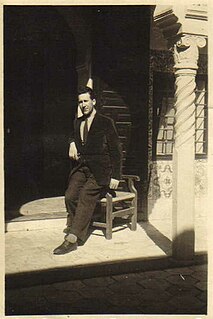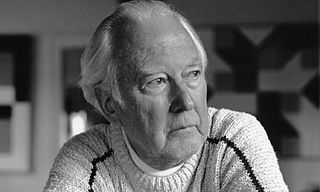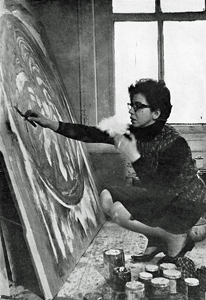
The Salon, or rarely Paris Salon, beginning in 1667 was the official art exhibition of the Académie des Beaux-Arts in Paris. Between 1748 and 1890 it was arguably the greatest annual or biennial art event in the Western world. At the 1761 Salon, thirty-three painters, nine sculptors, and eleven engravers contributed. From 1881 onward, it has been managed by the Société des Artistes Français.
Bernard Buffet was a French painter, printmaker, and sculptor.

Maurice Boitel was a French painter.

Maurice Braun (1877–1941) was an American artist who became known for his Impressionist landscapes of southern California. He was born in Hungary on October 1, 1877; however, by the age of four, young Maurice and the Braun family had migrated to United States, and settled in New York City. His professional studies took him to the National Academy of Design, where he studied the French tradition under Francis C. Jones, George W. Maynard and Edgar M. Ward.
Allan Sekula was an American photographer, writer, filmmaker, theorist and critic. From 1985 until his death in 2013, he taught at California Institute of the Arts. His work frequently focused on large economic systems, or "the imaginary and material geographies of the advanced capitalist world."

Christopher Georgesco is an American sculptor. He is the son of modernist architect Haralamb H. Georgescu.

The Carrousel du Louvre is an underground shopping mall in Paris, France, managed by Unibail-Rodamco. The name refers to two nearby sites, the Louvre museum and the Place du Carrousel. The mall contains a famous skylight, La Pyramide Inversée, which plays an important role in the best-selling 2003 book The Da Vinci Code.
Roger Edward Kuntz was a highly accomplished Southern California landscape painter and a member of the Claremont Group of painters - professors and graduates of Pomona College, Scripps College, and the Claremont Graduate School. A figurative artist with an eye for abstract form, he won critical acclaim for striking compositions that transform an unusual array of subjects, including tennis players, domestic interiors, freeways, road signs, bathtubs and the Goodyear Blimp. A retrospective exhibition of his work, at the Laguna Art Museum in Laguna Beach, CA in 2009, was aptly titled "Roger Kuntz: The Shadow Between Representation and Abstraction". In the exhibition catalogue, curator Susan M. Anderson wrote: "Kuntz's work of the late 1950s and early 1960s quintessentially embodied the experimentation, fragmentation, and paradox in American culture of the time."
Francis de Erdely was a Hungarian-American artist who was renowned in Europe and the United States for his powerful figure paintings and drawings as well as for his teaching abilities.
Maxwell Hendler is an American painter. In 1975, he became the first contemporary artist to have pictures in the collection of the Metropolitan Museum of Art in New York.

John Dwyer McLaughlin was an American abstract painter. Based primarily in California, he was a pioneer in minimalism and hard-edge painting. Considered one of the most significant Californian postwar artists, McLaughlin painted a focused body of geometric works that are completely devoid of any connection to everyday experience and objects, inspired by the Japanese notion of the void. He aimed to create paintings devoid of any object hood including but not limited to a gestures, representations and figuration. This led him to the rectangle. Leveraging a technique of layering rectangular bars on adjacent planes, McLaughlin creates works that provoke introspection and, consequently, a greater understanding of one's relationship to nature.

Frederick Hammersley was an American abstract painter. His participation in the 1959 Four Abstract Classicists exhibit secured his place in art history.

Ethel Carrick, later Ethel Carrick Fox was an English Impressionist and Post-Impressionist painter. Much of her career was spent in France and in Australia, where she was associated with the movement known as the Heidelberg School.

Sonia Gechtoff was an American abstract expressionist painter. Her primary medium was painting but she also created drawings and prints.

George Herms is an American artist best known for creating assemblages out of discarded, often rusty, dirty or broken every-day objects, and juxtaposing those objects so as to infuse them with poetry, humor and meaning. He is also known for his works on paper, including works with ink, collage, drawing, paint and poetry. The prolific Herms has also created theater pieces, about which he has said, "I treat it as a Joseph Cornell box big enough that you can walk around in. It's just a continuation of my sculpture, one year at a time." Legendary curator Walter Hopps, who met Herms in 1956, "placed Herms on a dazzling continuum of assemblage artists that includes Pablo Picasso, Kurt Schwitters, Marcel Duchamp, and Joseph Cornell, as well as California luminaries Wallace Berman and Edward Kienholz." Often called a member of the West Coast Beat movement, Herms said that Wallace Berman taught him that "any object, even a mundane cast-off, could be of great interest if contextualized properly." "That’s my whole thing," Herms says. "I turn shit into gold. I just really want to see something I've never seen before." George Herms lives and works in Los Angeles.
Anthony Friedkin is an American photographer whose works have chronicled California's landscapes, cities and people. His topics include phenomena such as surf culture, prisons, cinema, and gay culture. Friedkin’s photographs have been exhibited in the Los Angeles County Museum of Art and the J. Paul Getty Museum. His photographs are included in major Museum collections: New York's Museum of Modern Art, The J. Paul Getty Museum and others. He is represented in numerous private collections as well. His pictures have been published in Japan, Russia, Europe, and many Fine Art magazines in America.

Ron Linden is a California abstract painter, independent curator, and associate professor of art at Los Angeles Harbor College, Wilmington. He lives and works in the San Pedro area of Los Angeles.
Robert Mars is a contemporary American artist known for his Futurelics Popforms celebrating icons of the Golden Era of the 1950s and 1960s.
Jim DeFrance was a West Coast artist known for his abstract, shaped panel paintings and meticulous constructions. He utilized a reductive process while incorporating architectural references, geometric foundations, and fine carpentry into his work. He was most known for his “Slot” paintings, where he developed a surface structure of trapezoids on top of a bold color field.
Pierre Roy was a French surrealist painter. He is known for his realistically painted compositions of ordinary objects in unexpected arrangements.










